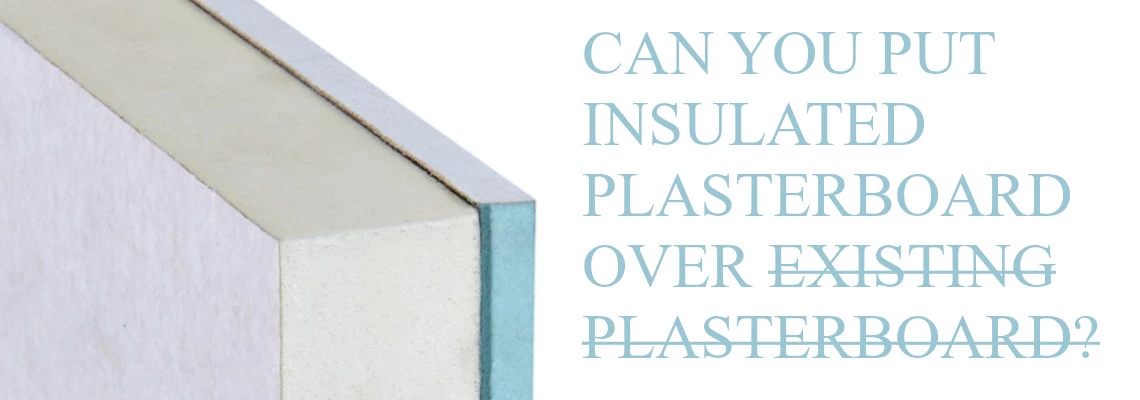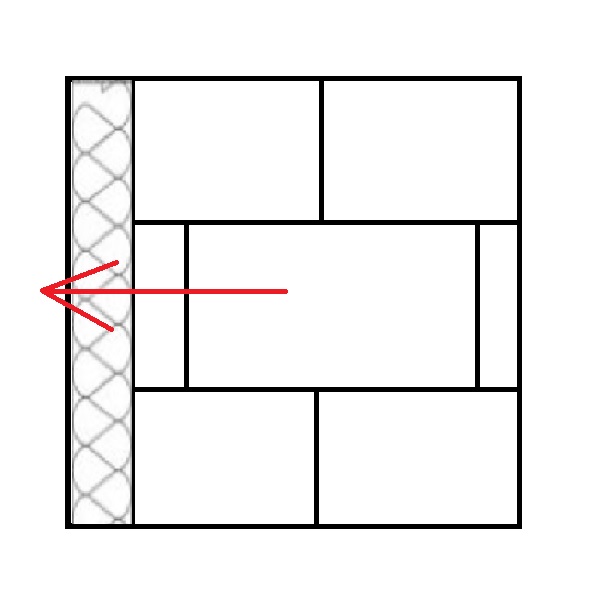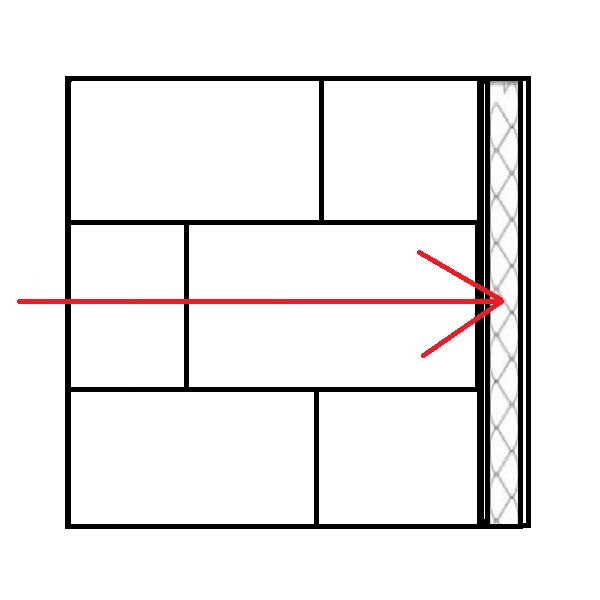
CAN YOU PUT INSULATED PLASTERBOARD OVER EXISTING PLASTERBOARD?*
Insulated plasterboard also known as thermal plasterboard is a real game-changer. It speeds the insulating process from the inside. While its installation is relatively straightforward on solid walls, fitting it onto existing plasterboard can be quite a challenge. In this article, we address this issue and answer the most commonly asked questions.
INSULATED PLASTERBOARD OVER OLD PLASTERBOARD SCENARIOS
According to our conversations with customers, it turns out that around 20% of them would like to put insulated plasterboard over existing plasterboard. Perhaps this isn't a significant percentage of people, but it doesn't change the fact that this issue continues to arise, and a clear solution isn't straightforward.
There are some specific situations when it would be best to install insulated plasterboard to existing plasterboard. Here they are:
The first, and perhaps the most crucial, is the cost-saving associated with potentially avoiding the removal of the old plasterboard – the expenses related to detaching it from the wall, skip costs, and the subsequent preparation of the surface, not to mention the mess involved.
The second situation where it would be most convenient for us to attach insulated plasterboard to old plasterboard is the desire to soundproof the wall. It might turn out that the old plasterboard isn't just a typical wallboard but an acoustic plasterboard, which is approximately 30% heavier than standard drywall and offers sound reduction of around 30-40dB.
The final situation where it would be most convenient for us to fix insulated plasterboard to old plasterboard is when there's a need for the fire resistance of the wall. There's increasing discussion about how installing two layers of gypsum boards in a house provides fire resistance of up to 60 minutes.
Each of the mentioned situations has its justifications, but when we break it down into fundamental factors and carefully consider each scenario, attaching insulated plasterboard to existing plasterboard doesn't seem to make much sense. Here is why.
SCENARIO 1 - ADDITIONAL WEIGHT CONCERNS
If, for any reason, we insist on installing insulated plasterboard to old plasterboard, it will undoubtedly come with consequences. Assuming the plasterboard was correctly attached to a solid wall in first place, and the wall was free of dust, with its plaster firmly secured, this shouldn't result in issues. Unfortunately, the majority of houses in the UK are older properties, and the quality of their plasterwork often leaves much to be desired. We discussed this in a separate article ‘When it's possible to attach insulated plasterboard onto existing plaster.’
In situations where old plasterboard is affixed to weak plaster, which is the case in most situations in the UK, the added weight from two layers of plasterboard, insulation, and the adhesive's weight may exceed the capability of the weakened plaster.
This could result in the plaster not being able to withstand this additional weight, leading to it loosening and consequently detaching from the wall, along with anything attached to it.
This is the most probable outcome of attaching insulated plasterboard to old plasterboard when the plaster is old and its strength isn't what it used to be decades ago.
SCENARIO 2 - SOUNDPROOFING
When trying to make walls quieter by adding insulated plasterboard onto existing ones, think twice about whether it really makes sense for reducing noise. Insulated plasterboard is good for keeping heat in or out but not so great at blocking sound.
Insulated plasterboard serves as an insulation material with good thermal conductivity, typically ranging between 0.018-0.022 W/mK. However, its acoustic properties aren't as impressive.
For better soundproofing, it's smarter to use heavier materials like rock wool.
For significant soundproofing, it's advisable to opt for different construction technologies such as timber or steel frames, utilising dedicated materials like rockwool RWA45 or RW3. Their high density makes them far more effective in reducing noise.
So, if your main goal is to make things quieter, sticking insulated plasterboard on top of existing plasterboard might not do the trick. Other types of insulation work better for reducing noise.
SCENARIO 3 - FIRE RESISTANCE
In the last scenario, when aiming to increase the fire resistance of a wall, installing insulated plasterboard over old plasterboard doesn't make much sense.
The primary reason behind this is the fire resistance rating of the insulated plasterboard, specifically its fire class E-F, indicating it can resist low flame ignition only for a brief period. This is where slabs from Rockwool's RW series come in handy. They are entirely fire-resistant and belong to class A1, which is the highest and most reliable class.
So, if you prioritise relatively high fire resistance, opting for insulated plasterboard over existing plasterboard might not be the best choice. In this case, it seems better to consider using just two layers of regular plasterboard without an additional fire-resistant core.
WHY PEOPLE CHOOSE TO PUT INSULATED PLASTERBOARD OVER OLD PLASTERBOARD DESPITE ASSOCIATED ISSUES?
Despite many arguments against installing insulated plasterboard over old plasterboard, many people still opt for it. Surely, this decision is influenced by costs because, when it comes down to it, it's about money.
Insulated plasterboard is usually installed on the external walls of a building, which accounts for only about ¼ of the room's surface. This might seem like a small and straightforward job, prompting many homeowners to tackle it themselves and become true DIYers.
Moreover, the costs associated with removing old plasterboard are not cheap. Hiring someone for this type of job can cost around £500-700 in the most optimistic scenario. Additionally, skip hire costs vary depending on the location, ranging from £200 to as much as £500.
Furthermore, after removing the old plasterboard, there will be additional expenses in preparing the wall for installing insulated plasterboard. This includes removing loose plaster, using PVA, and the associated time costs. This preparation can easily amount to another £400.
As you can see, the costs linked to removing old plasterboard are not low and extend the renovation time by several days.
WHY INSTALLING INSULATED PLASTERBOARD OVER OLD PLASTERBOARD ISN'T RECOMMENDED?
German engineers have proven that external wall insulation should be done from the outside rather than inside. It is closely linked to the movement of the dew point during freezes cycles.
When insulating the external wall from the exterior, the dew point is moved towards the outside of the building. Consequently, there's no risk of moisture buildup due to the recurring process of the dew point transition. The dew point occurs at a depth of 10 to 30mm and remains inside the insulation layer.

Pic. 1 External insulation dew point diagram
This situation changes when we need to insulate the external wall from the inside. Here, the dew point is shifted towards the interior of the room, as shown in the diagram below.

Pic. 2 Internal insulation dew point diagram
Why does this happen? An uninsulated external wall offers no thermal resistance to cold, allowing cold to penetrate the wall and only meet warmth at the boundary between the wall's surface and the interior space.
Now, imagine what happens when we install insulated plasterboard over old plasterboard. We separate the cold side of the wall from the interior, allowing the cold to progress towards the interior until it encounters the barrier, which in this case is the insulation core of the insulated plasterboard.
The first layer of old plasterboard won't block the cold and might even amplify the cold within its gypsum mass. Multiple instances of the dew point transitioning in this area can lead to moisture, weakening of the plaster, and consequently, detachment from the brick wall. Along the way, problems like unpleasant odours in the house, peeling paint, or the emergence of mould on the surface of the insulated plasterboard might be observed.
Therefore, it's better to get rid of the old plasterboard in the first place and attach insulated plasterboard directly to the solid wall, thereby altering the direction of the dew point.
CONCLUSION
In conclusion, while installing insulated plasterboard over old plasterboard might seem like a convenient solution, several critical considerations make it a less favorable option. The potential issues associated with moisture buildup, compromised insulation effectiveness, and structural integrity risks often outweigh the short-term benefits. Therefore, it's prudent to carefully evaluate the situation and consider alternative insulation methods or prioritize the removal of old plasterboard for a more effective and lasting solution.
Related articles:
How to install insulated plasterboard?
The power of ultra thin insulated plasterboard
Insulated plasterboard around windows
Worry-free tv setup: how to securely mount your tv on insulated plasterboard?
How to properly install insulated plasterboard on external corners?
The perfect fit: insulated plasterboard dimensions and options
Insulated plasterboard over plaster: short installation guide
Mastering insulated plasterboard fixings: best practices for solid walls.
A comprehensive guide to insulated plasterboard for ceiling insulation
Insulated plasterboard: finding the sweet spot for optimal thickness
Managing moisture: do you need a vapour barrier with insulated plasterboard?
Foil insulation: to gap or not to gap? that is the question!
The dangers of over insulating your home
5 Benefits of Insulated Plasterboard
3 Popular insulated plasterboard thicknesses
How To Dot & Dab Wall Insulation Boards
Rigid insulation board bonded to plasterboard. How does it sound?
Internal wall insulation - is it risky?
*Insulationgo LTD strives to keep the content accurate and up-to-date, but we cannot be held responsible for any mistakes or exclusions.
The information in this blog isn't expert advice and shouldn't replace talking to the right specialists. Before buying or deciding anything based on this info, it's best to contact the product manufacturer directly to double-check if it's right for what you need.
Descriptions, drawings, photographs, data, proportions, weights, and measured values provided here may change without prior notice and do not establish the guaranteed contractual quality of the products. The recipient of these products holds the responsibility to comply with proprietary rights, existing laws, and legislation.
Using this blog implies acknowledgment and agreement that Insulationgo LTD cannot be held accountable for any damages, losses, or inconveniences resulting from the use or reliance upon the information provided. This limitation of liability extends to all users of the blog, including visitors, readers, and subscribers.










































































































